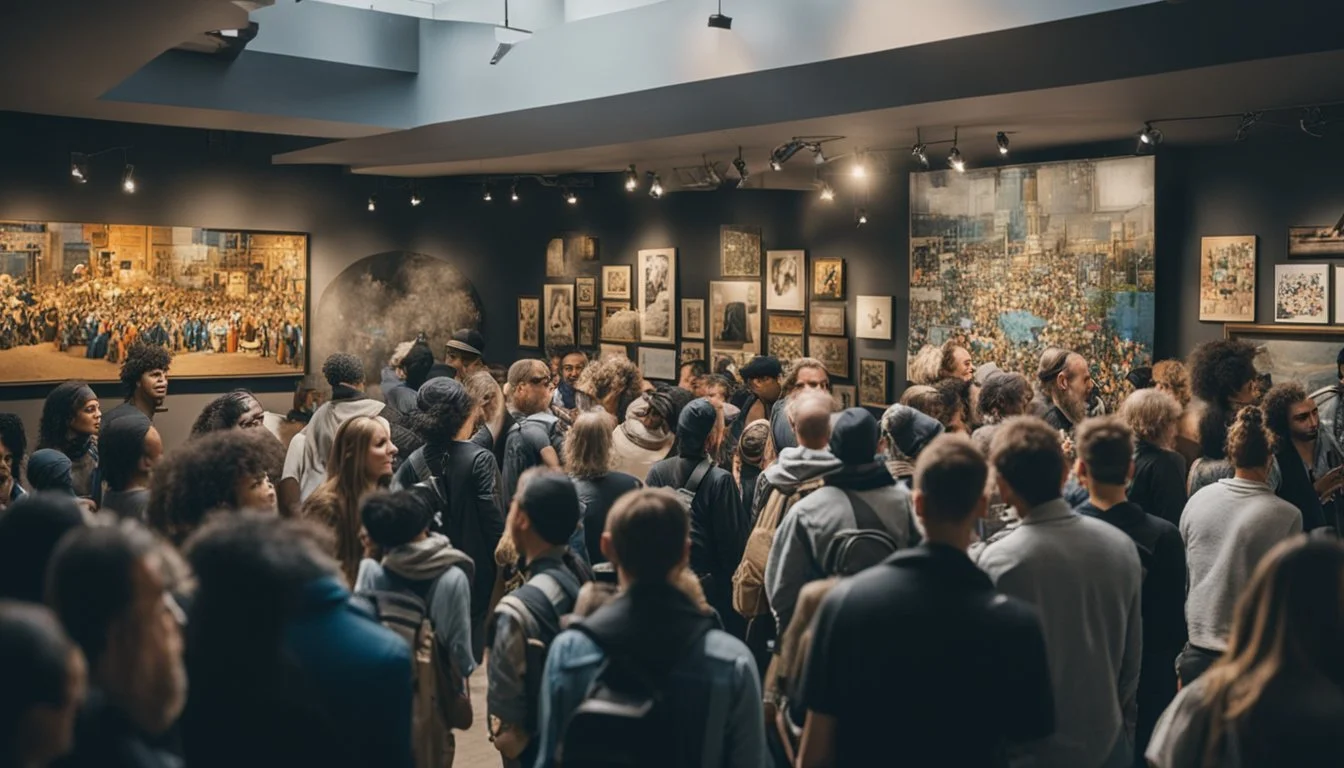Banksy Exit Through the Gift Shop Documentary Sparks Authenticity Debate
Banksy's "Exit Through the Gift Shop" sparked a fierce debate upon its release in 2010. The documentary, ostensibly about street art and its most famous practitioners, left audiences questioning its authenticity. Was this film a genuine exploration of the street art movement, or Banksy's most elaborate prank to date?
The movie follows Thierry Guetta, a French immigrant in Los Angeles who becomes obsessed with filming street artists. His journey leads him to encounter Banksy, the enigmatic British street artist known for his provocative and politically charged works. As the narrative unfolds, Guetta transforms into an artist himself, adopting the moniker "Mr. Brainwash" and staging a massive art show.
The ambiguity surrounding the film's true nature has kept it in the spotlight for years. Critics and viewers alike have dissected every frame, searching for clues to determine if Guetta is a real person or an actor playing a role in Banksy's grand scheme. This uncertainty adds another layer to the film's exploration of authenticity in art and the commodification of street culture.
The Enigma of Banksy
Banksy's elusive identity and provocative artwork have captivated the art world for decades. The mysterious street artist's anti-establishment messages and guerrilla tactics have left an indelible mark on urban landscapes globally.
Unmasking the Artist
Banksy's true identity remains unknown, sparking endless speculation and intrigue. The artist's anonymity is a crucial part of his mystique and message. Theories about Banksy's real name and background abound, but concrete evidence remains scarce.
Some believe Banksy is Robin Gunningham, a Bristol-born artist. Others speculate he's Robert Del Naja from Massive Attack. Despite numerous attempts to unmask him, Banksy has successfully maintained his secret identity.
This anonymity allows Banksy to critique society without personal consequences. It also adds value to his work, as the mystery fuels public fascination.
Impact on Street Art Culture
Banksy's influence on street art culture is profound and far-reaching. His stenciled graffiti style has inspired countless imitators and elevated street art to mainstream acceptance.
Banksy's works often appear overnight in unexpected locations. They tackle political and social issues with biting satire and dark humor. His pieces have sold for millions at auction, challenging traditional art market norms.
The artist's anti-capitalist stance contrasts sharply with the high prices his works command. This paradox highlights the complex relationship between street art and commercialization.
Banksy's guerrilla tactics and subversive messages have redefined public art. He's turned city walls into canvases for social commentary, encouraging viewers to question authority and societal norms.
Unraveling 'Exit Through the Gift Shop'
Banksy's 'Exit Through the Gift Shop' blurs the lines between documentary and art. The film's unexpected twists and ambiguous nature have sparked debates about its authenticity and meaning.
Plot Synopsis and Structure
'Exit Through the Gift Shop' follows Thierry Guetta, a French immigrant in Los Angeles with an obsession for filming street artists. Guetta's journey leads him to encounter renowned figures like Shepard Fairey and Banksy.
The narrative takes an unexpected turn when Banksy encourages Guetta to create his own art. Guetta transforms into "Mr. Brainwash," staging a massive art show that achieves surprising success.
The film's structure cleverly shifts focus from Banksy to Guetta, subverting audience expectations. This unconventional approach adds to the documentary's enigmatic nature.
Critical Reception and Accolades
'Exit Through the Gift Shop' received widespread critical acclaim upon its release in 2010. Many praised its wit, originality, and thought-provoking exploration of the art world.
The film earned numerous accolades, including:
Oscar nomination for Best Documentary Feature
Independent Spirit Award for Best Documentary
Toronto Film Critics Association Award for Best First Feature
Critics lauded Banksy's directorial debut for its engaging storytelling and satirical edge. The documentary's ability to challenge perceptions of art and authenticity resonated strongly with audiences and reviewers alike.
Theories on the Film's Authenticity
The authenticity of 'Exit Through the Gift Shop' has been a subject of intense speculation. Many viewers and critics question whether the entire film is an elaborate hoax orchestrated by Banksy.
Key points of debate include:
The convenient timing of Guetta's transformation into Mr. Brainwash
The seemingly too-good-to-be-true narrative arc
Banksy's reputation for pranks and subversive art
Some argue that the film is a genuine documentary capturing real events. Others believe it's a carefully crafted commentary on the commercialization of street art.
Banksy has remained deliberately vague about the film's true nature, fueling ongoing discussions about its authenticity and deeper meanings.
Profiles of Key Figures
The enigmatic figures behind "Exit Through the Gift Shop" each played crucial roles in the film's narrative and impact on the art world. Their interactions and contributions shaped the documentary's exploration of street art culture.
Thierry Guetta aka Mr. Brainwash
Thierry Guetta, a French immigrant in Los Angeles, began as an obsessive videographer documenting street artists. His transformation into Mr. Brainwash, a sudden art world sensation, forms the crux of the film's narrative.
Guetta's journey from clothing store owner to street art documentarian to controversial artist raised questions about authenticity in the art world. His rapid rise to fame, marked by a massive 2008 Los Angeles exhibition, sparked debate on the nature of artistic merit and commercialization.
Mr. Brainwash's art style, often criticized as derivative, blends pop culture imagery with street art aesthetics. His success story blurs the line between genuine artistic expression and calculated marketing, a central theme in Banksy's documentary.
Interactions with Shepard Fairey
Shepard Fairey, renowned for his "Obey Giant" campaign and Obama "Hope" poster, played a significant role in Guetta's artistic journey. Fairey was one of the first major street artists Guetta filmed extensively.
Their relationship evolved from documentarian and subject to a more complex dynamic as Guetta entered the art world. Fairey's initial support of Guetta's artistic endeavors later gave way to skepticism about Mr. Brainwash's meteoric rise.
Fairey's presence in the film provides a counterpoint to Guetta's approach, highlighting the contrast between long-term artistic development and overnight success. His commentary offers insights into the street art community's reaction to Mr. Brainwash's emergence.
Contributions of Invader
Invader, the French street artist known for his pixelated mosaic installations, appears as another key figure in the documentary. His distinctive space invader-inspired artworks are featured prominently throughout the film.
As Guetta's cousin, Invader inadvertently introduced him to the world of street art. This connection sparked Guetta's obsession with documenting street artists and ultimately led to his encounters with Banksy.
Invader's methodical approach to creating and placing his artworks contrasts with Guetta's seemingly haphazard entry into the art world. His presence in the film underscores the diverse techniques and philosophies within street art culture.
Street Art in the Public Eye
Banksy's work and "Exit Through the Gift Shop" thrust street art into mainstream consciousness. This shift brought both acclaim and scrutiny to the underground art form.
Gallery Exhibitions
Banksy's "Barely Legal" exhibition in Los Angeles marked a turning point for street art. The 2006 show featured a live painted elephant, drawing massive crowds and media attention. This event helped legitimize street art in the fine art world.
Solo shows by street artists became more common in prestigious galleries. Shepard Fairey's work gained recognition beyond his "Obey" campaign. Mr. Brainwash's rapid rise to fame, as depicted in the film, exemplified this trend.
Public Reactions and Hype
"Exit Through the Gift Shop" generated significant buzz upon release. Critics debated whether the film was a genuine documentary or an elaborate hoax. This uncertainty fueled public interest and discussions about the nature of art.
Media coverage of street art increased dramatically. Auction houses began selling works by Banksy and other artists for substantial sums. Some praised this as democratization of art, while others criticized it as commercialization.
The film's success sparked a wave of interest in street art creation. Amateur artists emerged, inspired by the DIY ethos portrayed in the movie. This led to both an explosion of creativity and concerns about oversaturation in the street art scene.
The Art Market and Collectors
Banksy's work has significantly impacted the art market, challenging traditional notions of value and collection. His pieces fetch high prices at auctions, despite their origins as illegal street art.
Assessing the Value of Street Art
Street art's value stems from its ephemeral nature and cultural significance. Banksy's stencils, often created quickly and anonymously, gain monetary worth through their scarcity and the artist's reputation. Auction houses struggle to authenticate his works, as Banksy operates outside traditional art world channels. This uncertainty adds intrigue and, paradoxically, value to his pieces.
Some collectors have even removed entire walls featuring Banksy's art, sparking debates about ownership and preservation. The artist's critiques of commercialism, ironically, make his work more desirable in the market.
Role of Art Collectors
Art collectors play a crucial role in legitimizing street art. By acquiring Banksy's works, they elevate graffiti to fine art status. Collectors often view his pieces as investments, banking on the artist's growing fame.
Many seek Banksy's paintings for their provocative messages and cultural cachet. Some collectors display his works publicly, while others keep them in private collections. This demand has led to a thriving market for Banksy's art, with prices reaching millions at auction.
Collectors also face unique challenges, such as verifying authenticity and preserving works originally meant to be temporary. Their interest in Banksy has helped reshape perceptions of street art's value and place in the art world.
Behind the Scenes
"Exit Through the Gift Shop" offers intriguing glimpses into its unconventional production process. The film's creation involved unexpected collaborations and creative choices that shaped its distinctive style and narrative approach.
Production Insights
Banksy directed "Exit Through the Gift Shop" using footage originally shot by Thierry Guetta. The film's production took an unexpected turn when Banksy decided to shift focus onto Guetta himself.
Joachim Levy, a filmmaker who worked with Guetta, claimed he helped edit an early version of the documentary titled "Life Remote Control". This version was reportedly deemed unwatchable by Banksy, leading to the film's reframing.
The documentary premiered at the 2010 Sundance Film Festival, generating immediate buzz and speculation about its authenticity. Producers Distribution Agency handled the film's unconventional release strategy, bypassing traditional distribution channels.
Narration by Rhys Ifans
Welsh actor Rhys Ifans provided the film's narration, contributing significantly to its tone and pacing. His deadpan delivery complemented the documentary's satirical elements and helped maintain an air of mystery.
Ifans' narration guided viewers through the complex narrative, offering context and commentary on the unfolding events. His voice became an essential component in balancing the film's humorous and thought-provoking aspects.
The choice of Ifans as narrator added another layer of intrigue to the production, fueling discussions about the film's authenticity and Banksy's artistic intentions.
Music and Soundtrack Contributions
The film's soundtrack features an eclectic mix of music that enhances its energetic and often playful tone. Geoff Barrow of Portishead contributed original music, adding a distinctive sonic element to the documentary.
Notable tracks include Richard Hawley's "Tonight the Streets Are Ours" and songs by artists like Roni Size and Portishead. These musical choices reflect the diverse and vibrant nature of street art culture.
The soundtrack skillfully underscores key moments in the film, from tense encounters with law enforcement to the frenetic preparation for art shows. It plays a crucial role in maintaining the documentary's pace and atmosphere.
Cultural Impact and Legacy
"Exit Through the Gift Shop" sparked intense discussions about art, authenticity, and commercialization in the modern era. The film's influence extended far beyond the realm of street art, challenging established norms and perceptions.
Shifts in Artistic Aesthetics
The documentary highlighted the blurring lines between street art and commercialized pop art. It showcased how underground artistic movements could rapidly transform into mainstream phenomena.
Banksy's film introduced wider audiences to the aesthetics of street art, leading to increased appreciation and acceptance of urban art forms. This shift influenced gallery exhibitions, public art installations, and even advertising campaigns.
The film's portrayal of Mr. Brainwash's sudden rise to fame sparked debates about the nature of artistic talent and the role of marketing in the art world. It challenged traditional notions of artistic merit and skill.
The Conversation Around Art and Authenticity
"Exit Through the Gift Shop" ignited discussions about the nature of authenticity in art. It raised questions about the value of art created for commercial purposes versus art born from genuine creative expression.
The film's ambiguous narrative led viewers to question the authenticity of the documentary itself, mirroring broader debates about truth in media and art. This meta-commentary added layers to conversations about artistic integrity.
Critics and audiences debated whether Mr. Brainwash's work represented a valid artistic statement or a critique of the art market's susceptibility to hype. This dialogue extended to discussions about the commodification of counterculture and punk aesthetics.
The film's legacy continues in ongoing debates about the nature of creativity, originality, and the role of the artist in contemporary society.
Conclusion
'Exit Through the Gift Shop' remains a captivating enigma in the world of documentary filmmaking. Banksy's creation blurs the lines between reality and fiction, challenging viewers to question the nature of art and authenticity.
The film's ambiguity speaks to Banksy's artistic vision. It leaves audiences pondering whether they've witnessed a genuine documentary or an elaborate prank orchestrated by the elusive street artist.
This uncertainty adds layers of depth to the film's exploration of street art culture. It raises questions about the commercialization of a once-underground movement and the fickle nature of artistic fame.
Ultimately, 'Exit Through the Gift Shop' serves as both a celebration and critique of street art. It showcases the passion driving artists like Banksy while simultaneously exposing the potential pitfalls of mainstream success.
Whether fact or fiction, the film's impact on discussions surrounding art, authenticity, and fame is undeniable. It continues to provoke debate and analysis years after its release, cementing its place as a unique and influential work in the documentary genre.





